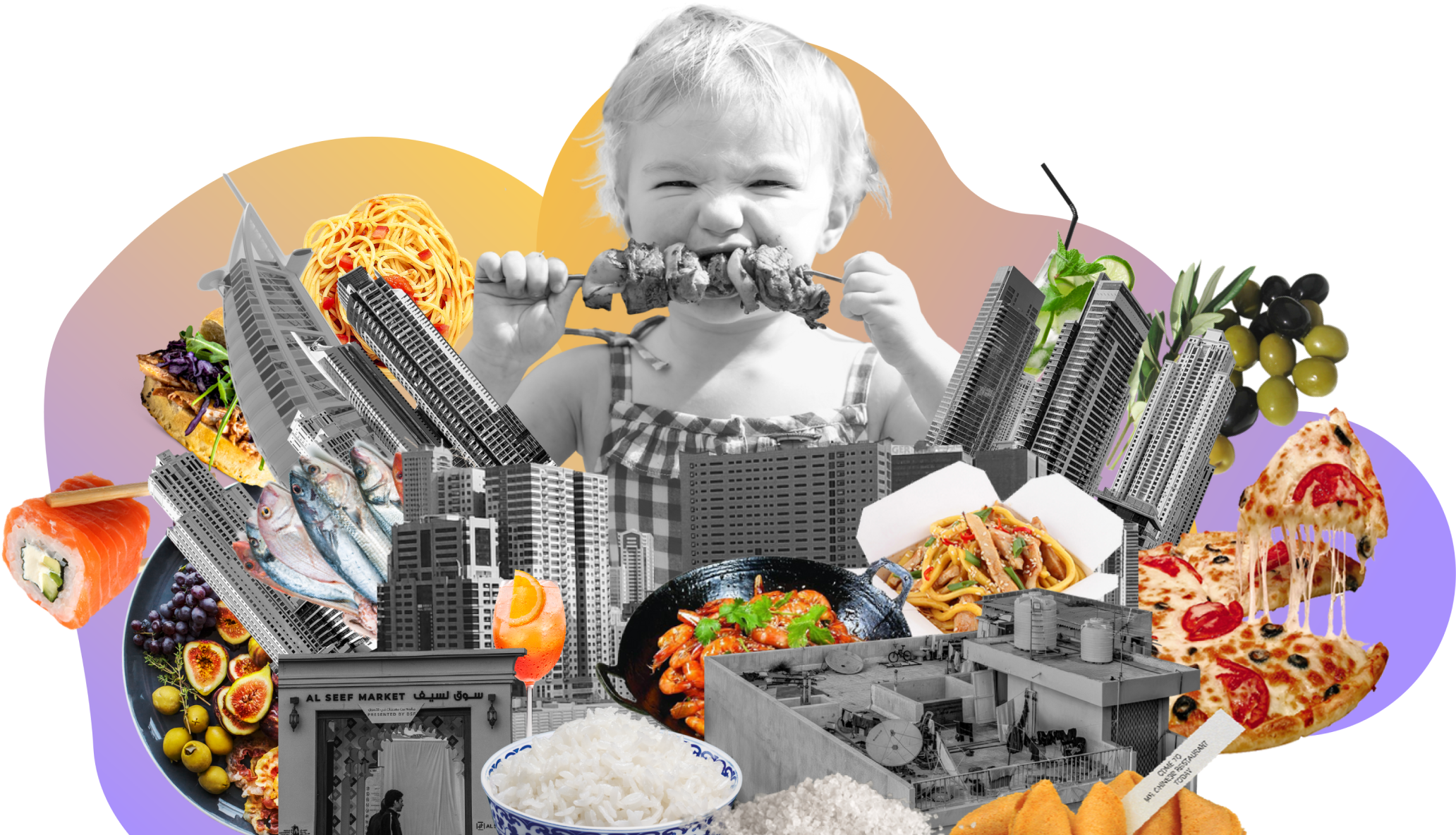- January 12, 2023
- 7 minutes
Pita burger and Arabic americano: exploring cuisine features and main restaurant centres in Dubai
Tranio analysts have studied the catering habits and food service geography of Dubai based on the OpenStreetMap (OSM) data. For connoisseurs of a variety of tastes, we have identified the top 15 districts of Dubai with the widest selection of cuisines from different countries. We have also found out which establishment formats and types of ethnic cuisine prevail in this multicultural metropolis.
Dubai now has about 3.3 million permanent residents representing more than 200 ethnic groups, as well as thousands of tourists, foreign businessmen and expats from all over the world. Major ethnic groups of the local population are Indians, Pakistanis and Iranians. The share of representatives of the Arab nations is only about 30%. The multinational image of modern Dubai develops a special gastronomic flavour.
Dubai is catching up with Europe's culinary capitals
In the late 2022, there were more than 7,500 catering establishments in Dubai, from eet cafes to enormous food halls with an area of 6,000 square metres. The city averages 226 establishments per 100,000 inhabitants, which is two times more than in Moscow and one and a half times more than in St. Petersburg. In terms of population, Dubai has overtaken most of the largest European cities, and in terms of catering establishments it is catching up with London (232 per 100,000 inhabitants), Rome (248), Barcelona (252) and even Paris (274), the culinary capital of Europe.
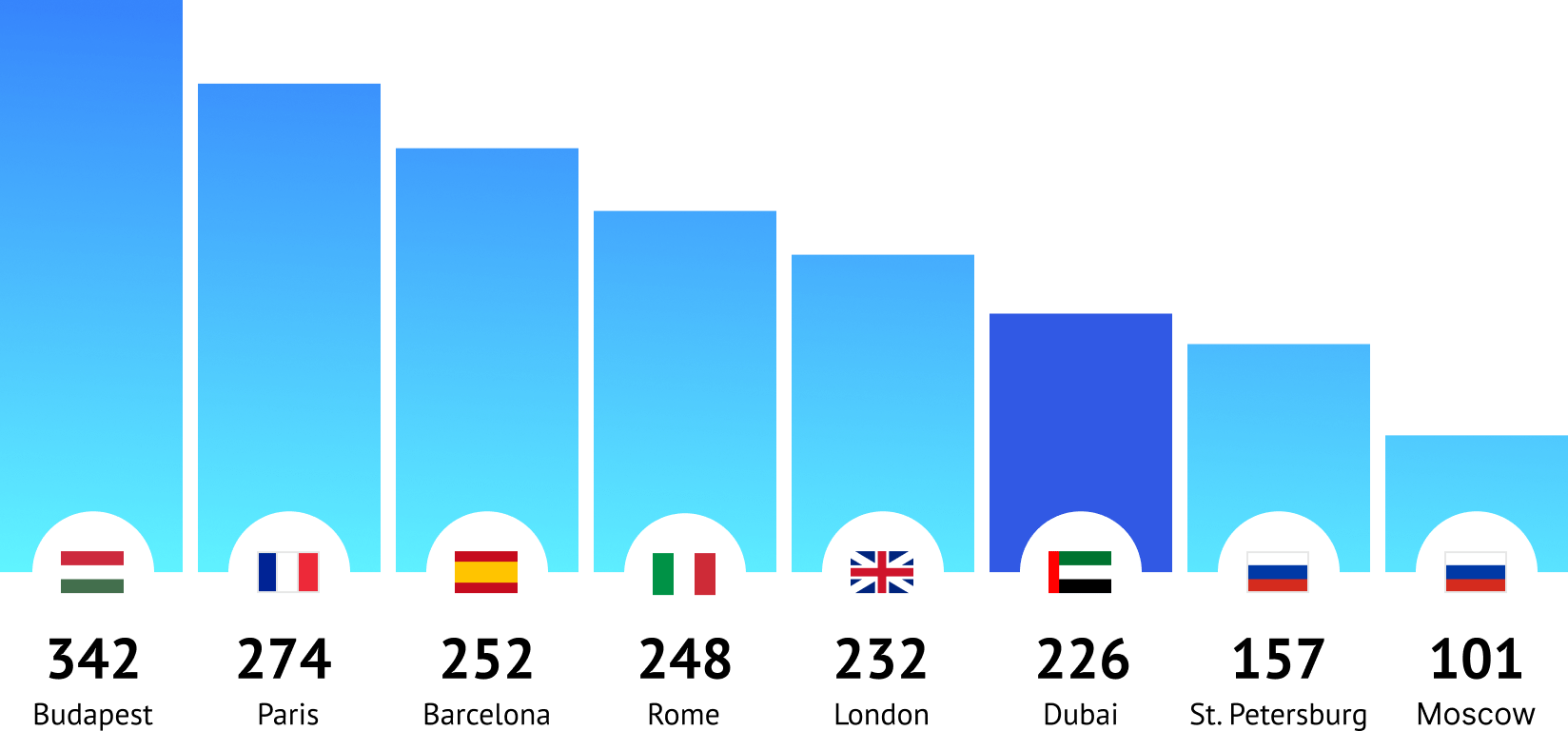
- Restaurants
- Restaurants turn out to be the main catering format here. There are more than 3,700 restaurants in Dubai, which is more than in Rome, Moscow and Prague. In the Middle Eastern metropolis, you can find restaurants with 60 types of national cuisine, among which it is worth noting a large number of diners and barbecue restaurants. Classic American diners with seating for large groups and cooking on the grill seem to fit well into the local family dining tradition.
- Сafeterias
- The second place in terms of the number of establishments hold cafeterias: there are more than 1,600 cafeterias in Dubai, and a significant part of them are located in malls. Large-scale food halls in shopping centres, sometimes stretching for a whole block, have become a kind of hallmark of the Emirates, where they like to build on a grand scale. However, in some areas of Dubai one can still encounter a traditional street retail format with small shops, cafes and bars.
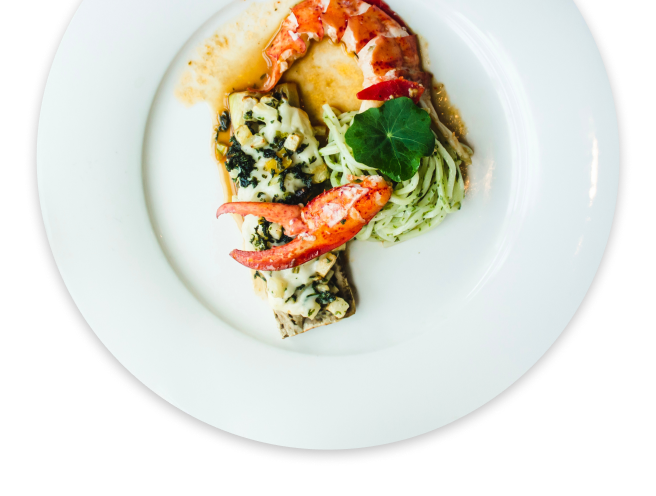
- restaurants
- 52%
- cafeterias
- 21%
- coffee shops and bakeries
- 13%
- fast food
- 11%
- bars
- 3%
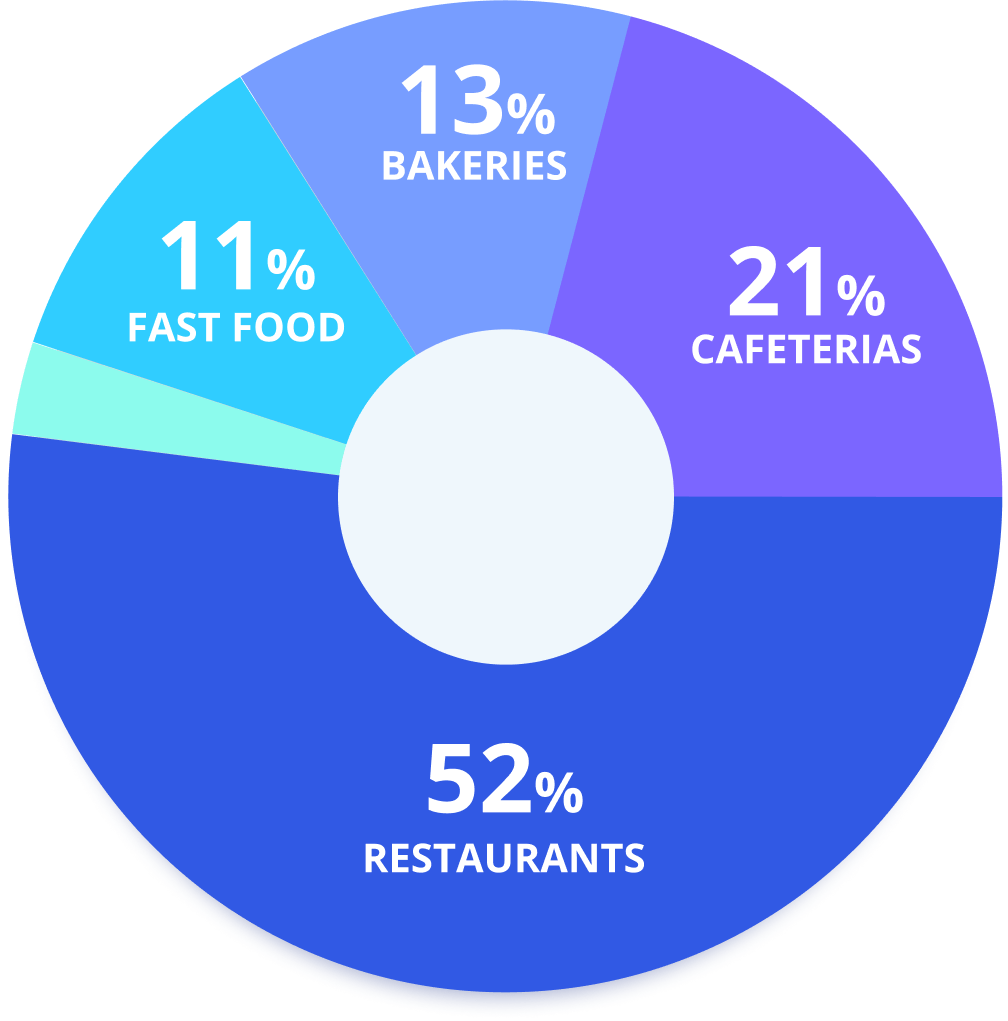

- Coffee shops and bakeries
- In the third category of popular establishments, we have combined coffee shops, tea houses, bakeries and patisserie cafes — all the places where you can order hot drinks and desserts. The love for aromatic coffee, tea and sweets is a feature of the local culture, thanks to which there are more than 1000 such establishments in Dubai with a selection of traditional Arabic coffee and desserts, as well as specialties from around the world. For example, the Arabica coffee shop chain in Dubai, which competes with Starbucks in the local market, offers Japanese green coffee lattes.
- Fast food
- In the fourth place in Dubai are fast food establishments. Among more than 800 fast food outlets in the city, there are major international franchises (McDonalds, KFC, Burger King, Subway, etc.), Indian chain restaurants with a large selection of spicy chicken dishes, Middle Eastern kebab houses with shawarmas, falafel and burgers on pita bread. Numerous stalls with street food from different cultures also fall into this category, from fluffy Belgian waffles to Thai roti pancakes.
- Bars
- The last in the top five common catering formats are bars, there are about 250 bars in Dubai. This is not much compared to European cities, but it is quite enough to serve tourists and expats from Western countries. There are few locally oriented bars in Dubai because about a quarter of the residents are Muslims, and the bulk of the population — immigrants from India — prefer establishments where you can both drink and eat, instead of purely drinking places. Alcoholic drinks are on the menu of most local restaurants, and hookahs can be ordered almost everywhere — often even in coffee shops and tea houses that do not serve alcohol.
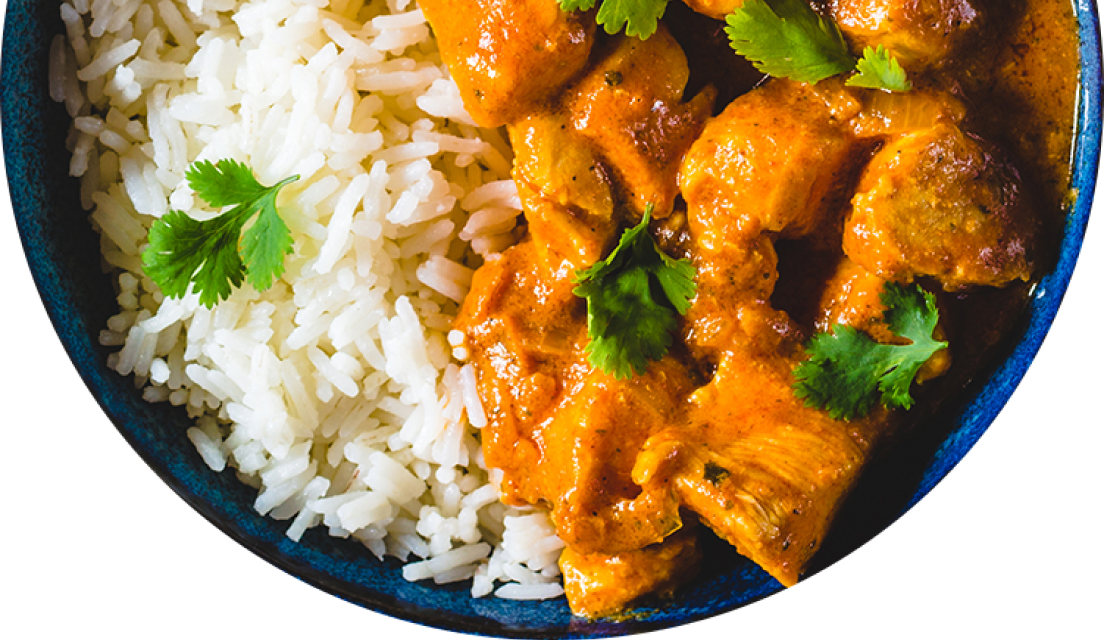
Number one dish in Dubai: chicken curry with Basmati fried rice
The preferences of residents who moved to Dubai from India and other countries have also influenced the dominant national cuisines in the city’s establishments. Indian cuisine is confidently leading in terms of the number of establishments and prevalence in different parts of the city. After studying the location and menu of Indian restaurants and cafes in Dubai, we came to the conclusion that statistically the main dish of the metropolis should be chicken curry with Basmati fried rice and vegetables. You can explore the rest of Dubai's popular dishes on your own using the data in our table.
Along with the previously mentioned Indian cuisine, Dubai is dominated by Middle Eastern, Pan-Asian, Italian and American cuisines. These are the top five common types of ethnic cuisine, which account for almost two-thirds of establishments.
The popularity of certain culinary traditions is influenced not only by the ethnic composition of residents, but also by the global trend towards “global-local” establishments. As part of this trend, international chain restaurants include special dishes on the menu in certain countries of presence, and local establishments for their part strive to create products according to world standards. Thus was the origin of oriental combo lunches with kebabs and Asian “pizzas” with unusual toppings.
A guide to multicultural cuisine districts in Dubai
There are 15 districts in Dubai with catering establishments that offer customers 12 or more types of ethnic cuisine. In most other areas, there is a choice of 5–6 ethnic cuisines, with the most common being Indian, Pan-Asian, Middle Eastern and Italian. There are almost no districts that are “monoethnic” in culinary terms; the choice of just two or three types of cuisine can only be seen in new areas that have recently begun to be built up.
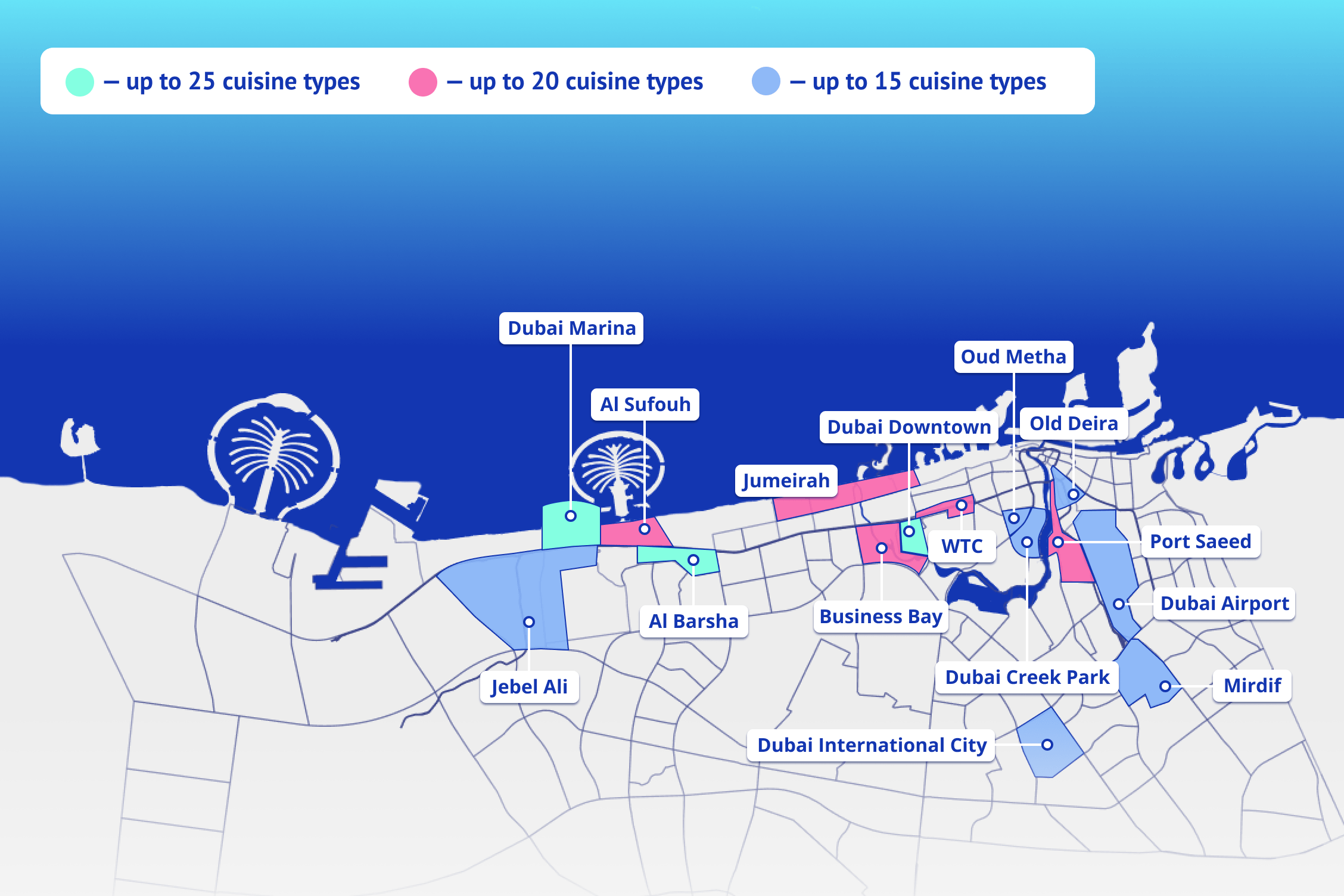
Having considered the options for ethnic cuisine in Dubai, it remains to be seen where exactly here you can find authentic Buffalo wings, fresh caprese salad or Hiroshima-style okonomiyaki. And what if you want to try everything at once, without taking long trips? There should be no problems with this, because according to geodata statistics, Dubai is well suited for lazy gastronomic tourism: the entire palette of ethnic cuisine is present in many central areas. However, each of the top 15 districts with the widest selection of national cuisines has its own specifics, which we will discuss below.
Dubai Marina: dolce vita for a cosmopolite
A favourite area among expats from the US and Europe, Dubai Marina is distinguished by a wide variety of catering formats: from democratic street food to stylish lounge bars. In total, there are more than 120 restaurants, 150 cafes, bistros and fast food outlets, and around 70 bars in the area, so the choice of alcohol here is greater than the average in the city. Along 7 kilometres of the Marsa Dubai canal, restaurants and cafes with outdoor terraces and sky lounges with panoramic views of the bay await their guests.
You can order dishes from 25 types of ethnic cuisine in Dubai Marina establishments, but Italian cuisine prevails. So, according to statistics, a gastronomic tour of the Marina will appeal to those who do not mind combining cannoli with aperol or chocolatini with bellini. If you get bored with the views from the embankment, you can dine both in the sea and in the sky above the Marina. The Dinner in the Sky attraction invites you to a dizzying adventure, and various excursion boats will take you for a boat trip, where treats and a glass of ice-cold prosecco are usually included in the ticket price.
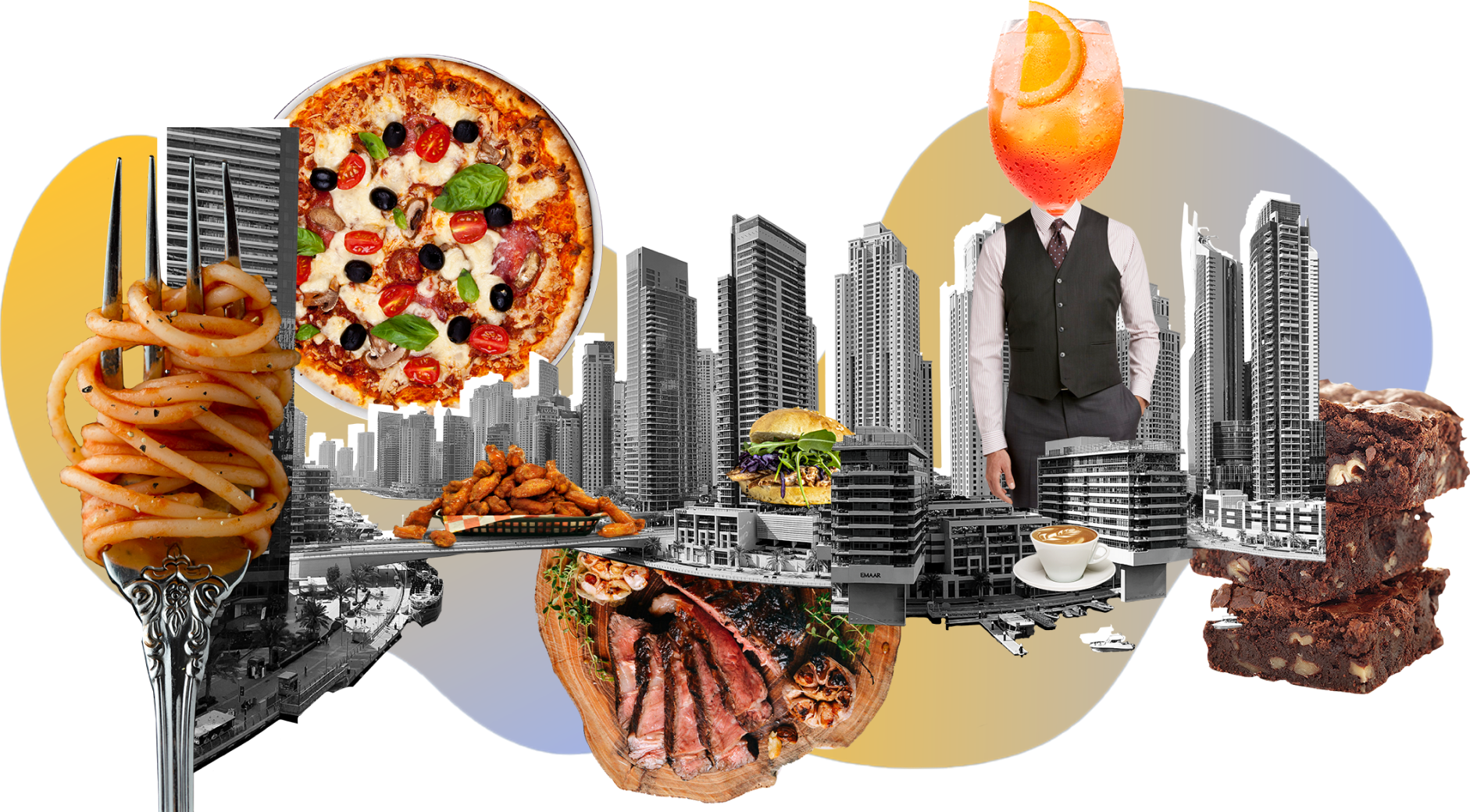
The american dream in Downtown: diners and rooftop bars
There are about 200 catering establishments in Downtown; some of them are as large as a baseball stadium. Most cafes and restaurants are concentrated in the Dubai Mall and along Bin Rashid Boulevard, which skirts Burj Park and the main square with an artificial lake. And in the heart of Downtown, there are about a dozen rooftop bars and restaurants with terraces that offer the best view of the Burj Khalifa Tower, the singing fountain and the Dubai Opera.
In the summer, due to the climate, all life in Dubai flows into malls; so many restaurateurs choose shopping centres as their main location. Here you can often see queues of customers waiting for a free table for 20–30 minutes, which is a good indicator of the establishments’ rating. For our first establishment we chose the Dubai Mall in Downtown, which is loved by our guests, both local and tourist.
Alina and Dima Tyutkov, founders of Angel Cakes
There are 21 types of national cuisine in Downtown, the main one among them is American — 10 restaurants and a couple dozen cafes and fast food kiosks specialise in it. Even with a small number of establishments, the influence of American gastronomic traditions is felt throughout Downtown: in multi-storey food halls, family barbecue restaurants, steakhouses and burger houses, drive-through establishments and pastry shops with classic brownies and cheesecakes. There is an American diner in the area with a reference menu from Sheldon Cooper's Texas childhood: Buffalo chicken, chef burger, mac and cheese, parmesan baked potatoes and spicy wings with barbecue sauce.

Al Sufouh: Italian cuisine in Arabian Venice
Al Sufouh is located on the Persian Gulf coast between Jumeirah and Dubai Marina. Its famous attraction is the Madinat Jumeirah quarter with artificial canals, which is called the Arabian Venice. No wonder that the main ethnic cuisine of the area is Italian. Dishes with seafood straight from the Gulf are always popular among tourists. For those who find pasta and pizza too boring, there are 18 types of ethnic cuisine in the area.
To the south of Arabian Venice are the palace complexes of Sheikh Zayed and Sheikh bin Rashid, beaches and residential areas. Further down the line Dubai Media City and Dubai Internet City free zones begin. The business district has a large selection of catering establishments, among which restaurants with Indian cuisine predominate. Italian, Mexican and Thai cuisines are also popular among local “media and internet people”. You can’t do without a Big Mac and a pita burger either, so global and local fast food brands are also widely represented here.
Chinese samovar and Arabian bazaar: the flavour of the old city in Deira
Deira is one of the oldest parts of the city, which is located on the northern bank of the Dubai Creek. The territory of Deira stretches to the border with Sharjah and it is difficult to get around the entire district, still here we have discovered locations with the richest choice of national cuisines in the Al Muraqqabbat and Al Rigga areas. Al Muraqqabbat is located north of the Deira Clocktower, while Al Rigga metro station is in the centre of the district. But the Al Rigga area itself lies to the west, its territory is stretched along the coast of the Dubai Creek, from the Union metro station to the Al Sabkha pier. Establishments in these two small areas offer a choice of 19 types of ethnic cuisine, among which the most common are Chinese and Japanese. Numerous restaurants and bistros are scattered along the Al Rigga Road and adjacent streets, as well as around the Al Ghurair shopping centre. Here you can find wok cafes, sushi bars, dumpling and seafood restaurants, and establishments with Middle Eastern, Indian and international cuisine.
Many Chinese establishments are located near the Union metro station. You need to come here while being really hungry, because how else can you cope with a serving of Szechuan chicken or Hong Kong ramen? There are also traditional restaurants serving hot pots, popularly known as Chinese samovars — boiling pots of broth, into which you can dip thin slices of meat and bacon, shrimp, tofu, mushrooms and other snacks. All the options can be tried at a table with a conveniently rotating tabletop. After having lunch in this area, you can walk to the Deira Old Souk bazaar: it takes 25 minutes to get there on foot from the Union metro. There is also a gold market and a spice market nearby.
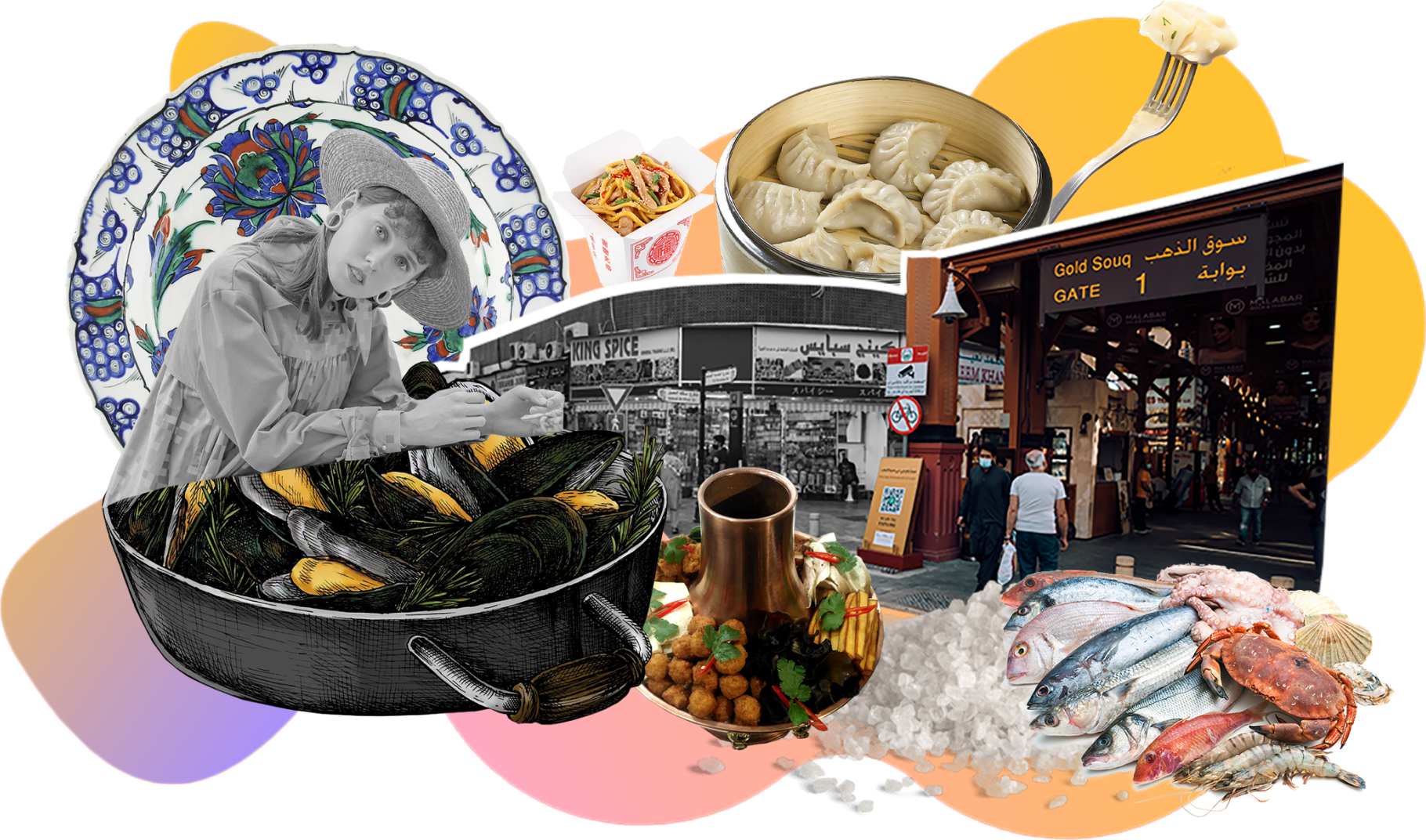
World Trade Centre: international culinary congress
The World Trade Centre (WTC) is the oldest business district in Dubai. One of the first skyscrapers in the Emirates was erected here in 1979. It was first called the Sheikh Rashid Tower, but later renamed the World Trade Centre, which gave its name to the whole area. Although the two-hundred-metre WTC tower can no longer compete with skyscrapers in the new business centres of the city, this area still retains its importance for the business life of Dubai. International exhibitions and conferences, as well as concerts and city fairs, regularly take place in the WTC pavilions.
As usual in locations where international events are regularly held, the main streets of the area are lined with hotels, offices, restaurants and bars, and, of course, the global franchises of McDonald's, KFC, Starbucks, etc. However, apart from a few streets parallel to the metro line, no other territories are included in the administrative districts of WTC 1 and WTC 2. This allows us to get a fairly accurate picture of the culinary standards in the business environment of Dubai: a choice of 21 types of ethnic cuisine is available here, with the most prevalent being American, Italian and Middle Eastern cuisine. Catering formats are not limited to restaurants and bars at hotels and the food courts of business centres: there are almost 200 establishments in the area, including kiosks with local fast food and hookahs, tea houses and a couple of British gastro pubs.
Oud Metha: the 1980s Dubai Tour
Oud Metha is located in the old part of Dubai, between Bur Dubai and Al Karama. In the mid-1980s this area was considered the centre of the city, but the further rapid development ofDubai “moved” the location to the modern outskirts. The former importance of the area isevidenced by its developed infrastructure: there is a large-scale Al Nasr Leisureland sportscomplex with a professional football school and many sports and leisure sections for amateurs. The local Al Maktoum stadium still hosts home matches of the Dubai club Al Nasr. Cafes andrestaurants in Oud Metha gravitate towards sports facilities or office centres. In total, 18 typesof national cuisine are presented in the establishments of the district, with a predominantshare of Indian, Pakistani and Pan-Asian.
Dubai International City: peace, friendship and mega market
Where else should there be a large selection of cuisines from different countries, if not in the area called Dubai International City? DICity is a low-rise suburb where residential areas are named after different countries of the world. The concept is reflected in the architectural details: for example, Arabian arched windows and arches on the facades in the Persian quarter, colourful lattice shutters in the Moroccan quarter, or spacious terraces with columns in the Spanish quarter. In the north of DICity there is even a quarter of “Russian” five-storey buildings; fortunately, without references to the architectural style of the Khrushchev era.
The young district for 60,000 residents has its own park with an artificial lake and a large shopping centre with retail and wholesale stores of Chinese goods: furniture, electronics, clothing, etc. This is the world's largest mall with products from Chinese manufacturers outside of China itself, so here buyers come from the Emirates and from abroad. A large food court with restaurants, cafes and fast food from different countries is located here. The most common ethnic cuisines here are Indian and Chinese, but in the international residential areas of DICity there are many establishments with dishes from all over the world. For example, here you can find restaurants of Mongolian, African, Egyptian and Afghan cuisines.
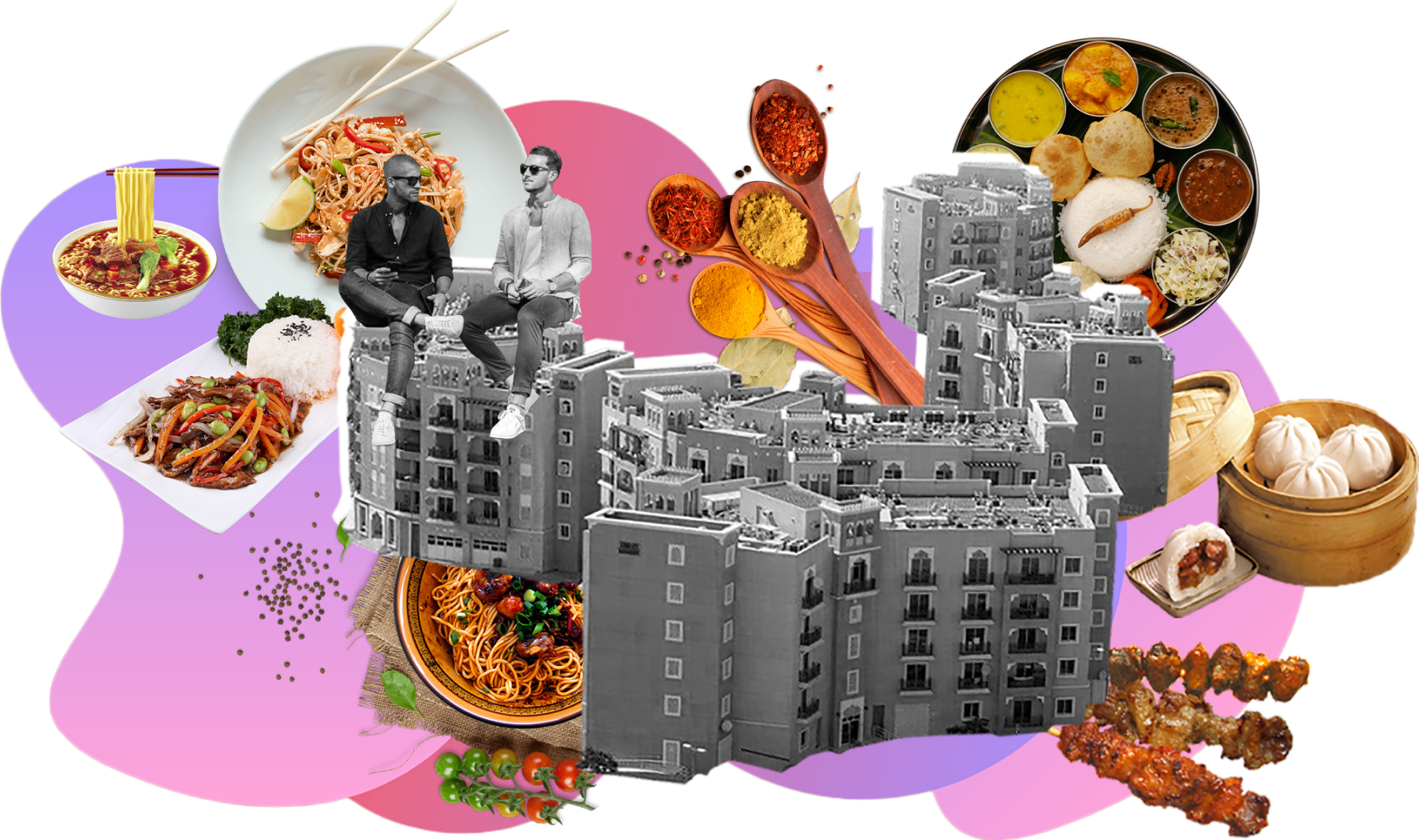
Jebel Ali: Ibn Battuta's culinary journeys
Jebel Ali is home to Dubai's oldest free economic zone — the Jebel Ali Free Zone (JAFZA), founded in 1985. There are more than 8,700 residents here, who are attracted by the possibilities of duty-free trade and the developed infrastructure of the free zone: a seaport and the Al Maktoum international airport — a modern hub for sorting and sending cargo of various types, from fuel to microelectronics. Not only transport and trade companies operate in JAFZA, but also representatives of the IT and telecom industry: for example, the data centre of the mobile operator Etisalat is located here. In the field of catering in JAFZA, Indian cuisine is the most popular, but these are the establishments with a modern interpretation of the culinary traditions of India: vegetarian cafes and healthy food restaurants, bistros with combo lunch parties and snack bars where you can take coffee or masala chai with puri.
In order to attract leading companies from all over the world to JAFZA, favourable conditions have been created here both for entrepreneurs and their employees. In the suburban area of Jebel Ali Village, where there was a small village in the 1980s, comfortable villas and residential complexes, clinics, schools, sports centres and, of course, shopping centres were built. The local Ibn Battuta Mall is the largest themed mall not only in the UAE, but in the world as well. Its architectural concept is inspired by Ibn Battuta, a 14th-century Berber traveller and merchant. The layouts and decor reflect the routes of his wanderings through the shopping and restaurant halls of Tunisia, Egypt, Andalusia, Persia, India and China. Thanks to the ambitions of Ibn Battuta and the developers of the mall, Jebel Ali Village brings together establishments with ethnic cuisine from 18 regions of the world.

Seafood in Jumeirah
Jumeirah is a long coastal region with public and private beaches, hotels and tourist infrastructure, as well as residential and administrative districts. The coastline boundaries of the district include areas from La Mer beach in the north to Kite Beach in the south. For tourists and local residents of Jumeirah there are more than 270 catering establishments, where 16 types of ethnic cuisine are present. The most numerous of them are American, Middle Eastern and Mediterranean.
Most of the establishments with Mediterranean cuisine are located in the vicinity of La Mer and Mercato Beach, and Jumeirah Fishing Harbour is located south of the latter. There is also a fish market and many sea restaurants where you can appreciate dishes made with a fresh catch. The Persian Gulf is home to not only fish, but also lobsters, shrimp, octopus and squid — the menu of seafood will never be monotonous. In addition, in beach areas there are always burgers, grill bars, kebab houses and other establishments with American and Middle Eastern cuisines.
Dubai Airport: first in flights, tenth in ethnic cuisine
Dubai International Airport is the largest air hub in the world, which received 88 million passengers and 2.67 million tons of cargo last year. On transcontinental flights by Emirates, Air Arabia and other local companies, Dubai acts as a bridge between Tokyo and New York or London and Sydney. Therefore, it is quite predictable that the airport ranks in the top 10 areas with the largest selection of national cuisines from different countries. In total, 16 types of ethnic cuisine can be found in the establishments of the administrative district of the airport, the most common of them are Indian, Italian and American.
Mirdif: an oriental tale of the Dubai suburbs
The Mirdif residential area is located in the north-eastern part of Dubai. The area is dominated by communities with private villas, but there are also neighbourhoods with low-rise apartment buildings. Villas with a garden and a pool in the backyard, spacious layouts of apartments and the infrastructure of the area — everything is focused on family residents. In all quarters of Mirdif there are enough schools, children's centres and clinics, malls and fitness clubs, and from the east the district borders a large public park. Here you can walk along the green alleys, do yoga or engage in horseback riding, swim and relax by the pool, visit the rope park or even the planetarium.
Catering establishments are concentrated in malls and community centres, of which there are about a dozen in Mirdif. For example, Abaya Mall specialises in women's fashion in the Middle Eastern tradition, and Mirdif City Centre alone has more than 110 catering establishments. Along with cafes and diners, healthy food restaurants are singled out here as a separate group. There are more than 230 establishments per 30,000 residents in the entire district, which makes Mirdif the second in Dubai in terms of availability of catering establishments. Local residents are presented with a selection of dishes from different regions of the world as there are 16 types of ethnic cuisine in Mirdif. Middle Eastern cuisine is the most popular here, there are also a lot of pastry shops and bakeries, where you can feast on fresh knafeh with soft goat cheese, luqaimat donuts and chebab pancakes. That is why malls need a separate category of healthy food restaurants.
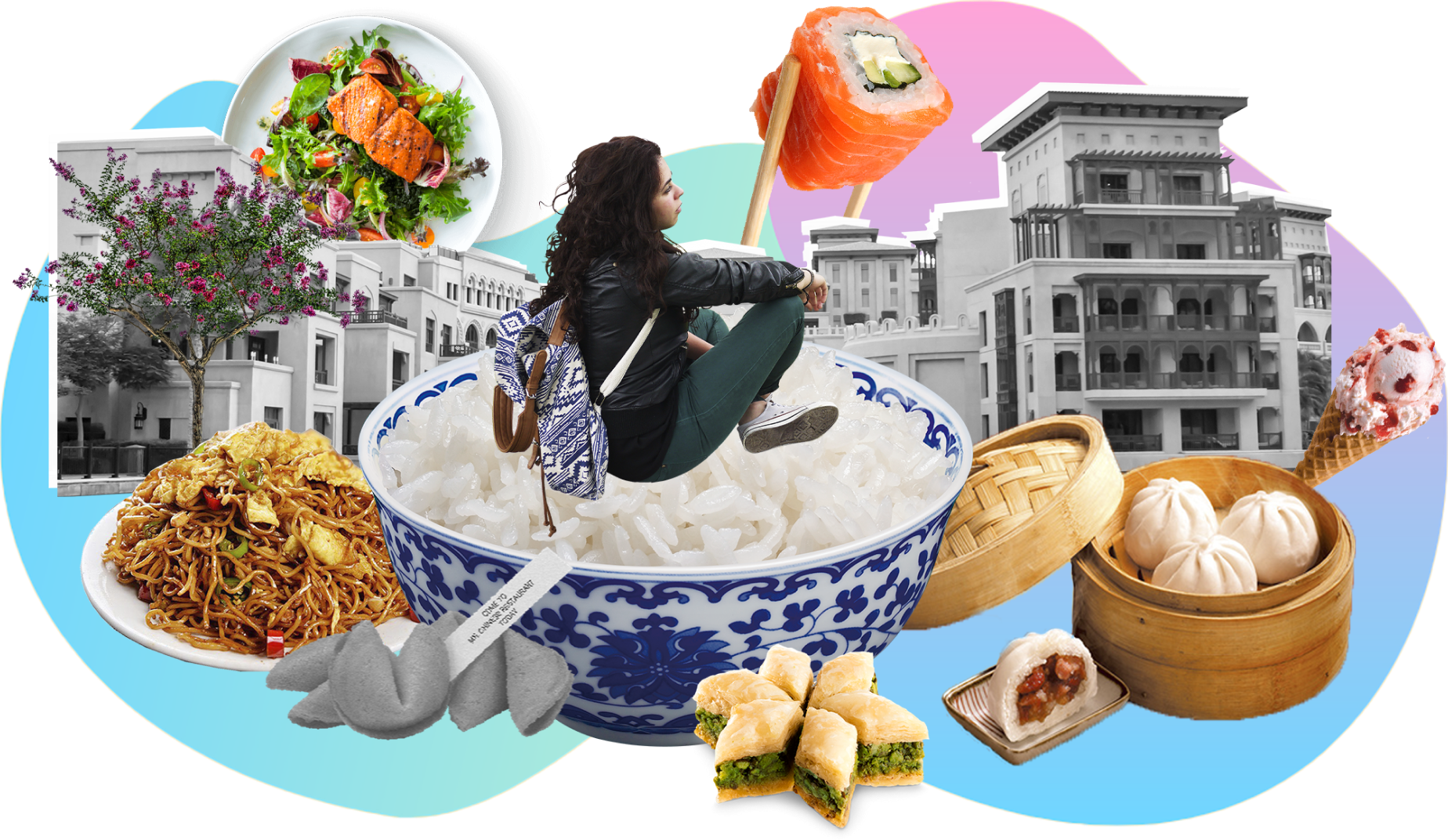
A quiet harbour of Port Saeed
The Port Saeed area belongs to Deira, but almost does not capture its historical quarters, which are closer to the Gulf. According to the administrative division, the port area includes a significant part of the coastline north of the Dubai Creek Canal: along with the ship docks and the old Dhow Wharfage, the Jewel of the Creek shopping and office centre and the territory of the Creek Golf & Yacht Club. Only in the central part, the district includes residential and commercial areas, located in the vicinity of the Deira metro station and the Deira City Centre mall. Most of the catering establishments are located here, and among the 14 types of ethnic cuisine available in the area, Indian and Pan-Asian cuisines prevail.
Due to its location, the Port Saeed area has many waterfront restaurants and cafes, overlooking the main attractions on the south bank of the canal: the old city, the recreated mediaeval Al Seef quarter, Sheikh Ahmed Palace and Dubai Creek Park. However, it should be noted that the coastline of Dubai Creek has been developed to a much lesser extent than in Dubai Marina and it still continues to be built up. So far, most of the restaurants with a picturesque view of the canal are located near the pier of the yacht club and the Hyatt Park hotel complex. It is thanks to the cafes and restaurants in this part of Port Saeed that restaurants with American cuisine have become the most common establishments.
Coffee shops and falafel burgers: modern oriental cuisine in Business Bay
The modern business district of Business Bay borders Downtown in the northern part, its territory includes coastal areas on both sides of the Al Jaddaf Canal, which then flows into Dubai Creek. On the coastline there are high-rise business centres, hotels and apart-hotels with panoramic restaurants and rooftop bars. The district has high transport connectivity. There are 5 bridges with broadband roads, thanks to which the coast on the Ras Al Khor side is not cut off from Downtown. Many people deliberately choose the restaurant terraces on this side of the canal, which offer a view of the Burj Khalifa.
Establishments in the Business Bay area offer a choice of 14 types of ethnic cuisine, which is dominated by Middle Eastern, Indian and Italian. In cafes in local business centres, you can try kebabs on pita bread, shawarmas and burgers with falafel, combo lunches with hummus and baba ganoush. Not so long ago, Sheikh Hamdan, the Crown Prince of Dubai, published a post on his Instagram about a local burger joint. Sheikh Hamdan is the most respected food blogger in Dubai, and getting into the rating of restaurants approved by the Sheikh is no less honourable than getting a Michelin star. You can relax here after a long day and feel the atmosphere of the East in coffee shops and hookah places on the waterfront.
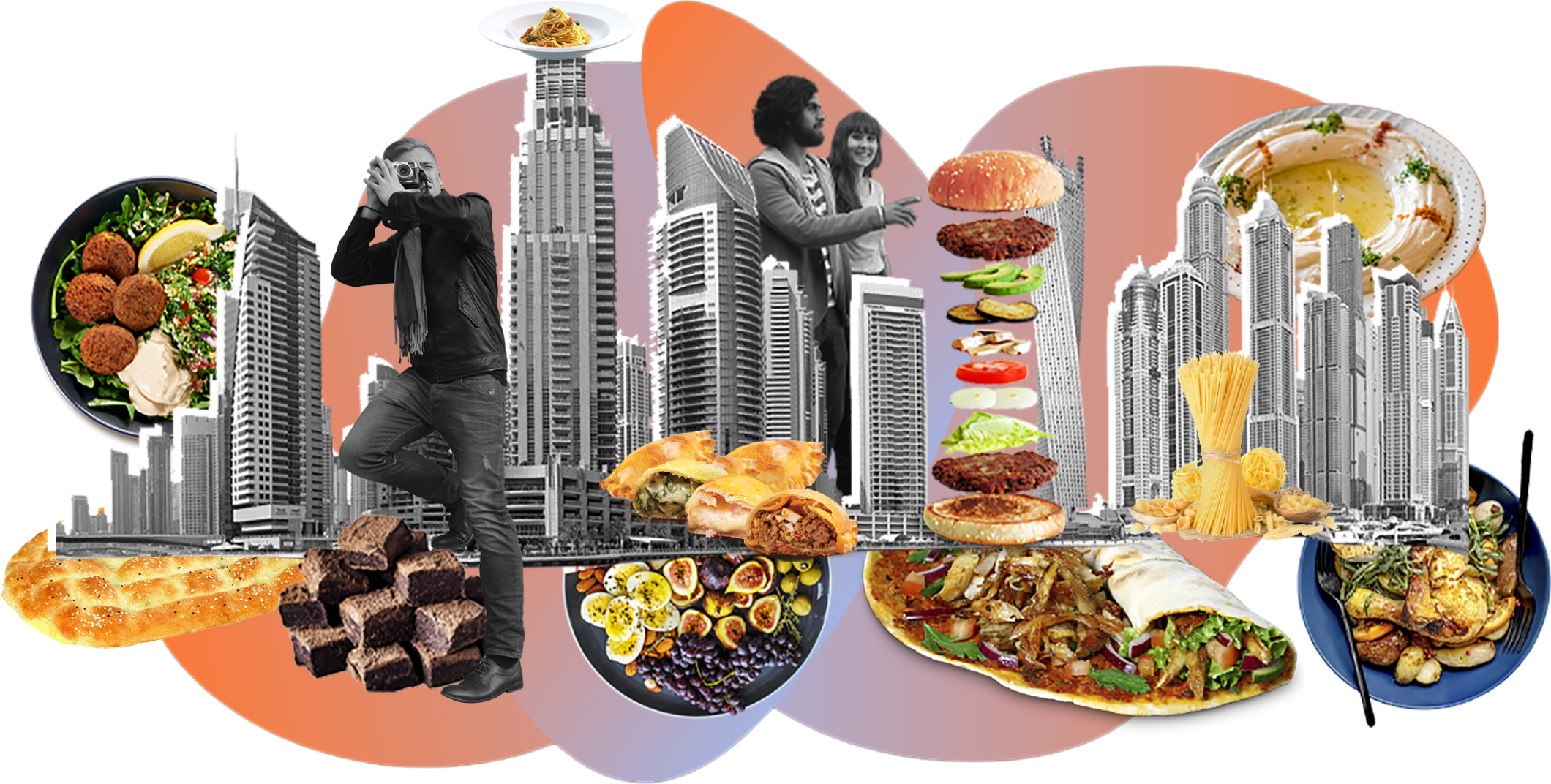
The simple charm of Dubai Creek Park
The administrative district of Umm Hurair, to which the Dubai Creek Park’s territory belongs, can be divided into three zones:
1) a park zone on the banks of Dubai Creek Canal;
2) a state institutions’ quarter in the western part;
3) a zone of educational and clinical centres.
In Dubai Creek Park there is a children's science centre and a dolphinarium, in the administrative quarter there are court and prosecutor's offices. The main part of the territory is reserved for medical and educational institutions: the Rashid Hospital complex, the Dubai Healthcare Centre, the Dubai Medical University, international and Arab private schools, as well as language and special schools. Most of the catering establishments are in the eastern part of the district, where the Wafi Mall and several large hotels are located. Thus, the Grand Hyatt Dubai has a large restaurant complex and a nightclub. In total, Dubai Creek Park features establishments with 12 types of ethnic cuisine, among which Italian, Indian and Pan-Asian are the most common.
The cuisine of Dubai restaurants is multiethnic, and the concept is global
A wide selection of ethnic cuisines fully meets the needs of residents, who have moved to Dubai from different parts of the world. Meanwhile, experts note that customer segmentation based on nationality is becoming a thing of the past. Nowadays, the concept of establishments in Dubai, similar to other metropolitan cities, is based on values and lifestyle choices.
The restaurant business in Dubai is developing vigorously: many expats open restaurants of the same format as in London, Moscow and other cities. But it cannot be said that they specialise in national cuisine: the concept of the establishment, its uniqueness and relevance are much more important right now. For example, our format is in line with the global trend — caring for people. We express it through healthy gluten and refined sugar free recipes, vegan positions, sustainable materials.
When launching projects in different countries, it is important to take into account local specifics, but the concept, quality and understanding of trends will always come first: projects made with heart and attentiveness to people will be able to find their devotees in any world capital.
Alina and Dima Tyutkov, founders of Angel Cakes
Authors of the study: Elena Skrebkova, Diana Imamgayazova
